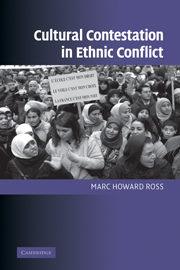Book contents
- Frontmatter
- Contents
- List of figures
- Preface
- 1 Introduction: easy questions and hard answers, what are they fighting about?
- 2 The political psychology of competing narratives
- 3 Narratives and performance: ritual enactment and psychocultural dramas in ethnic conflict
- 4 Loyalist parades in Northern Ireland as recurring psychocultural dramas
- 5 Where is Barcelona? Imagining the nation without a state
- 6 Digging up the past to contest the present: politics and archeology in Jerusalem's Old City
- 7 Dressed to express: Islamic headscarves in French schools
- 8 The politics of memory and memorialization in post-apartheid South Africa
- 9 Enlarging South Africa's symbolic landscape
- 10 Flags, heroes, and statues: inclusive versus exclusive identity markers in the American South
- 11 Culture's central role in ethnic conflict
- References
- Index
- Cambridge Cultural Social Studies
10 - Flags, heroes, and statues: inclusive versus exclusive identity markers in the American South
Published online by Cambridge University Press: 22 September 2009
- Frontmatter
- Contents
- List of figures
- Preface
- 1 Introduction: easy questions and hard answers, what are they fighting about?
- 2 The political psychology of competing narratives
- 3 Narratives and performance: ritual enactment and psychocultural dramas in ethnic conflict
- 4 Loyalist parades in Northern Ireland as recurring psychocultural dramas
- 5 Where is Barcelona? Imagining the nation without a state
- 6 Digging up the past to contest the present: politics and archeology in Jerusalem's Old City
- 7 Dressed to express: Islamic headscarves in French schools
- 8 The politics of memory and memorialization in post-apartheid South Africa
- 9 Enlarging South Africa's symbolic landscape
- 10 Flags, heroes, and statues: inclusive versus exclusive identity markers in the American South
- 11 Culture's central role in ethnic conflict
- References
- Index
- Cambridge Cultural Social Studies
Summary
A theme running through the previous chapters is that in symbolic conflicts the specific objects of contention are the surface manifestations of deeper issues of identity, recognition, inclusion-exclusion, and respect. As Bryan (personal communication) noted in the case of Loyal Order parades in Northern Ireland, “Parades conflicts aren't about parades.” They are about the threatened identities of Protestants and Catholics and each group's mutually experienced lack of respect. In this chapter, I examine how flags and monuments can be the surface manifestation of conflict over issues of race and power (Leib 2002: 306).
In previous chapters, the substantive cases have all come from societies other than my own, although I have also lived in France a good deal on and off over the past thirty-five years. Here I apply the tools and insights from the cases I have already considered to show their relevance for understanding race in the United States. The Lost Cause narrative is a powerful example of a socially constructed narrative that played a politically significant role in the effort to come to terms with the legacy of the Civil War and slavery in the US. It framed white American understandings of race in both the North and South for decades and was not seriously challenged politically until 100 years after the Civil War. The narrative not only reflected existing views on race, but at times exacerbated differences, and shaped behavior, as it made some actions more or less socially and politically plausible than others.
- Type
- Chapter
- Information
- Cultural Contestation in Ethnic Conflict , pp. 280 - 311Publisher: Cambridge University PressPrint publication year: 2007



